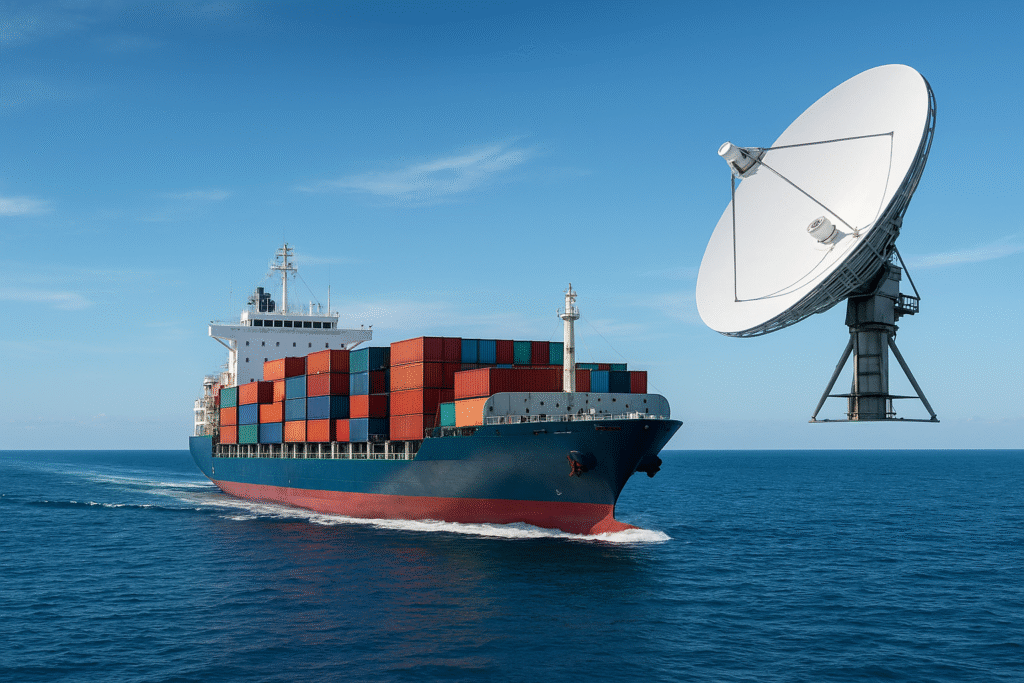Marine Satellite Communications: Ensuring Seamless Connectivity at Sea
In today’s interconnected world, communication is critical, and it’s no different on the open ocean. Marine satellite communications has become the lifeline for vessels of all sizes, ensuring safety, operational efficiency, and crew welfare. At Nautical Marine, we provide a full range of satellite solutions to keep you connected, no matter how far your voyage takes you.
The Need for Constant Connectivity
Beyond the range of coastal cell towers, satellite communication is the only way to reliably send and receive data, make phone calls, and access the internet. This connectivity is essential for:
- Safety and Emergencies: Instant communication with shore-based emergency services and search and rescue teams is vital in a crisis. Systems like Inmarsat and Iridium provide a global network for distress calls.
- Operational Efficiency: Real-time data transmission allows for efficient fleet management, remote troubleshooting, weather updates, and route optimization, which saves time and fuel.
- Crew Welfare: Providing internet access and the ability for crew members to connect with family and friends significantly boosts morale and retention, a key factor for any successful maritime operation.
Our Marine Satellite Communications Solutions
We offer a curated selection of the industry’s most trusted marine satellite communications systems and services, tailored to meet the specific needs of your vessel.
- Satellite Phones: For voice communication and basic data transfer, a satellite phone provides a reliable and portable solution with global coverage, ideal for smaller vessels and emergency backups.
- Broadband Terminals: Systems like VSAT and FleetBroadband offer high-speed internet access, enabling you to manage business operations, stream data, and provide Wi-Fi for your crew.
- Airtime Services: We provide flexible and cost-effective airtime plans, including prepaid and postpaid options, to power your satellite devices. This ensures you have the connectivity you need without unnecessary costs.
- GMDSS Compliance: We specialize in installing and maintaining satellite systems that meet GMDSS regulations, ensuring your vessel is compliant with all international safety standards.
By partnering with Nautical Marine, you are investing in peace of mind. Our expertise ensures you have the right Marine satellite communications tools to stay safe, efficient, and connected on every journey.
How Marine Satellite Technology Works ?
Marine satellite communication systems connect vessels at sea with orbiting satellites positioned thousands of kilometers above Earth.
When a signal is transmitted from the ship’s antenna, it’s relayed to a satellite in orbit, which then sends it back to a ground station or another vessel.
This link enables two-way voice, data, and internet communication across oceans and remote maritime zones.
Modern marine systems typically use:
GEO (Geostationary Earth Orbit) satellites — stable coverage but higher latency.
LEO (Low Earth Orbit) satellites — lower latency, faster data speeds (e.g., Starlink, OneWeb).
These technologies together ensure continuous and high-quality connectivity, even in challenging maritime environments.
Applications of Satellite Communication in the Maritime Industry
Satellite communication plays a vital role across various maritime operations
Commercial Shipping:
Enables real-time cargo tracking, remote diagnostics, and weather route optimization to reduce costs and enhance fuel efficiency.
Offshore Operations:
Supports drilling platforms, survey ships, and service vessels by providing reliable communication for crew coordination and data exchange.
Fishing & Coastal Vessels:
Provides navigation, safety, and communication tools for smaller vessels operating beyond cellular range.
Passenger & Cruise Ships:
Delivers high-speed Wi-Fi, entertainment, and safety communication for passengers and crew.
Naval & Defense Vessels:
Ensures secure and encrypted data transfer for mission-critical operations and real-time situational awareness.

FREQUENTLY ASKED QUESTIONS (FAQs):
What is Marine Satellite Communication?
Marine satellite communication refers to the use of satellite systems to transmit voice, data, and internet signals between ships and shore stations. It enables vessels to maintain reliable communication even when sailing far from coastal coverage zones.
Why is satellite communication important for vessels at sea?
Satellite communication is essential for maintaining safety, operational efficiency, and crew welfare. It allows vessels to send emergency alerts, receive weather updates, optimize routes, and provide crew access to the internet and calls during long voyages.
What are the main types of marine satellite communication systems?
Common types include:
-
VSAT (Very Small Aperture Terminal): Provides high-speed broadband for data and internet.
-
FleetBroadband (Inmarsat): Offers global coverage for voice and moderate data services.
-
Iridium & Thuraya Phones: Used for portable voice communication and emergency backup.
How does VSAT technology benefit ship operations?
VSAT systems deliver continuous high-speed internet that supports real-time weather updates, engine monitoring, remote diagnostics, and communication between vessels and shore offices—improving both efficiency and safety.
Is marine satellite communication available globally?
Yes. Systems like Inmarsat, Iridium, and Thuraya provide global coverage, including remote oceanic regions where terrestrial networks are unavailable.
